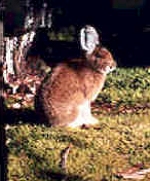
Snowshoe Hare
Lepus americanus
Status
Native to Labrador. Introduced to the Island around 1860.
Habitat
Snowshoe hares prefer dense stands (usually after a disturbance) of young conifers or brushy deciduous growth where there is lots of food and good shelter. In mature forests hare numbers are generally lower.
Range
Snowshoe hares are found in North America throughout much of the boreal forest. In the southern part of this forest in the East they are found along the Appalachian Mountains and west along the Rocky mountains far south as North Carolina and New Mexico. To the north, their distribution reaches as far as the Arctic Ocean.
Food
Snowshoe hares feed on a variety of deciduous trees and shrubs, (birch, willow, maple), some conifers (white pine, balsam fir), grasses and wild plants (raspberry and fireweed).
Predators/Threats
Common predators include the lynx, colored fox, coyote, great horned owl and goshawk. The snowshoe hare goes through what is called cyclic fluctuations about every ten years. When hare numbers are high, species populations like the lynx start to increase and when hare populations go down the lynx population will also decrease.
Lifespan
Some live more than 3 years in the wild and can live up to 8 years in captivity.
Appearance
The snowshoe hare is a large-footed animal that turns white in winter and a dark brown in summer. The large feet help the hare to stay on top of the snow in winter.
Average Weight/Measurements
Average hare weighs around (2 – 4 lbs)(0.9 – 1.8 kg); average length is (16 – 20 inches)(413 – 518 mm).
Breeding Biology
Snowshoe hares usually have two or three litters a year born from April to August. Litter size ranges from 1-8 young. Gestation period is between 36 to 37 days. The young nurse once a day and support themselves after three weeks.
Notes:
- Trails or runways are made by snowshoe hares between feeding and resting sites.
- The snowshoe hare is an important food source for many residents of this Province, with 1.5 million hares being consumed annually.
- Although commonly known in Newfoundland as “rabbits”, they are actually hares.
- Because their diet of wood fibre is difficult to digest, hares eat their droppings to extract additional nutrients not absorbed on the first attempt.
At Salmonier Nature Park
- Hares are one of the most common wild mammals encountered at Salmonier Nature Park.
- Hares displayed within the Park in the summer are released back to the wild in the Fall.
